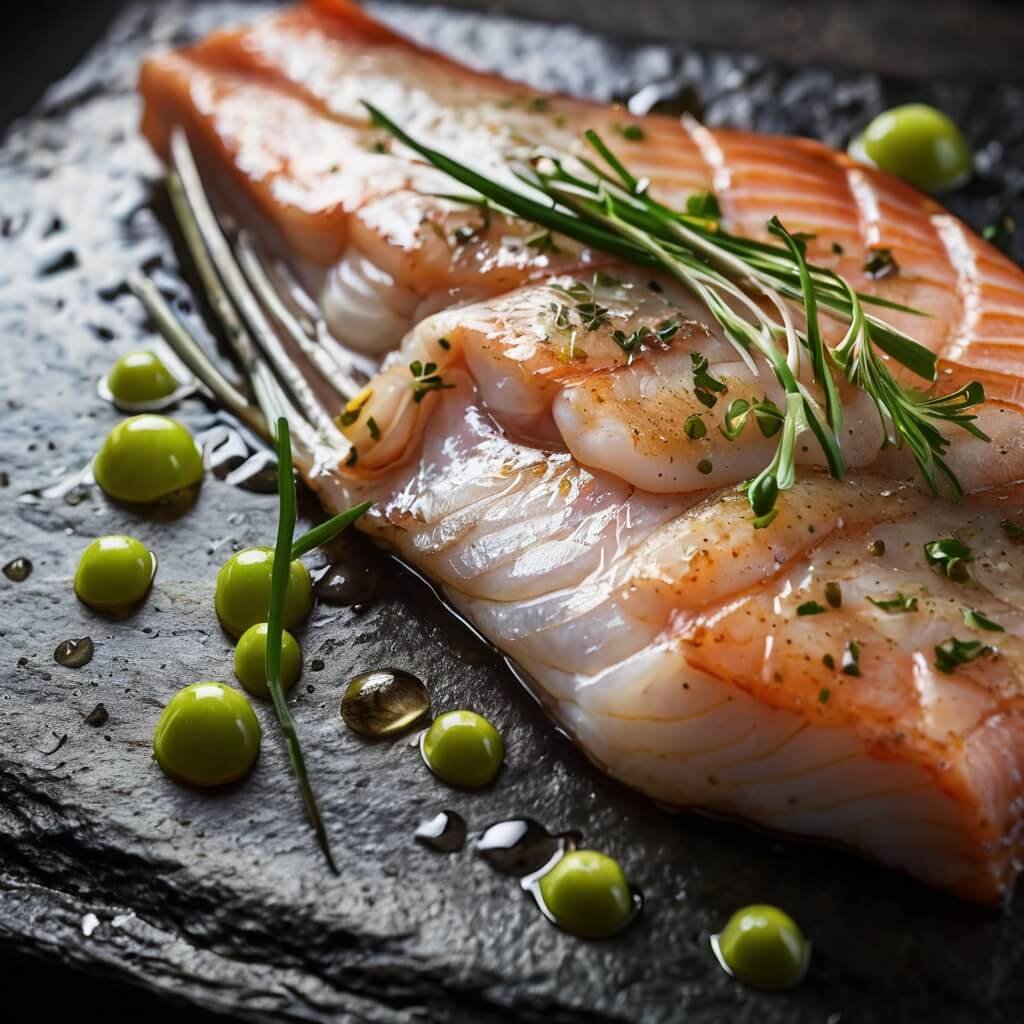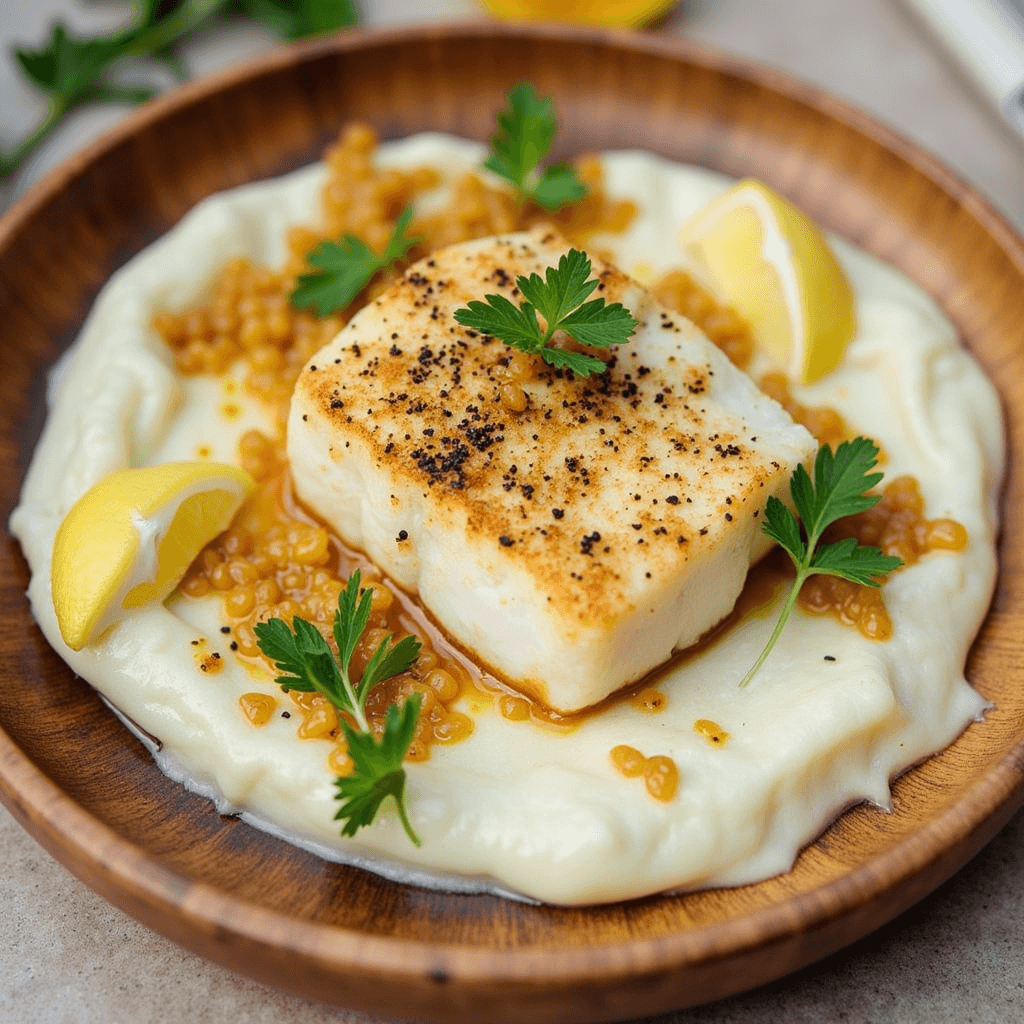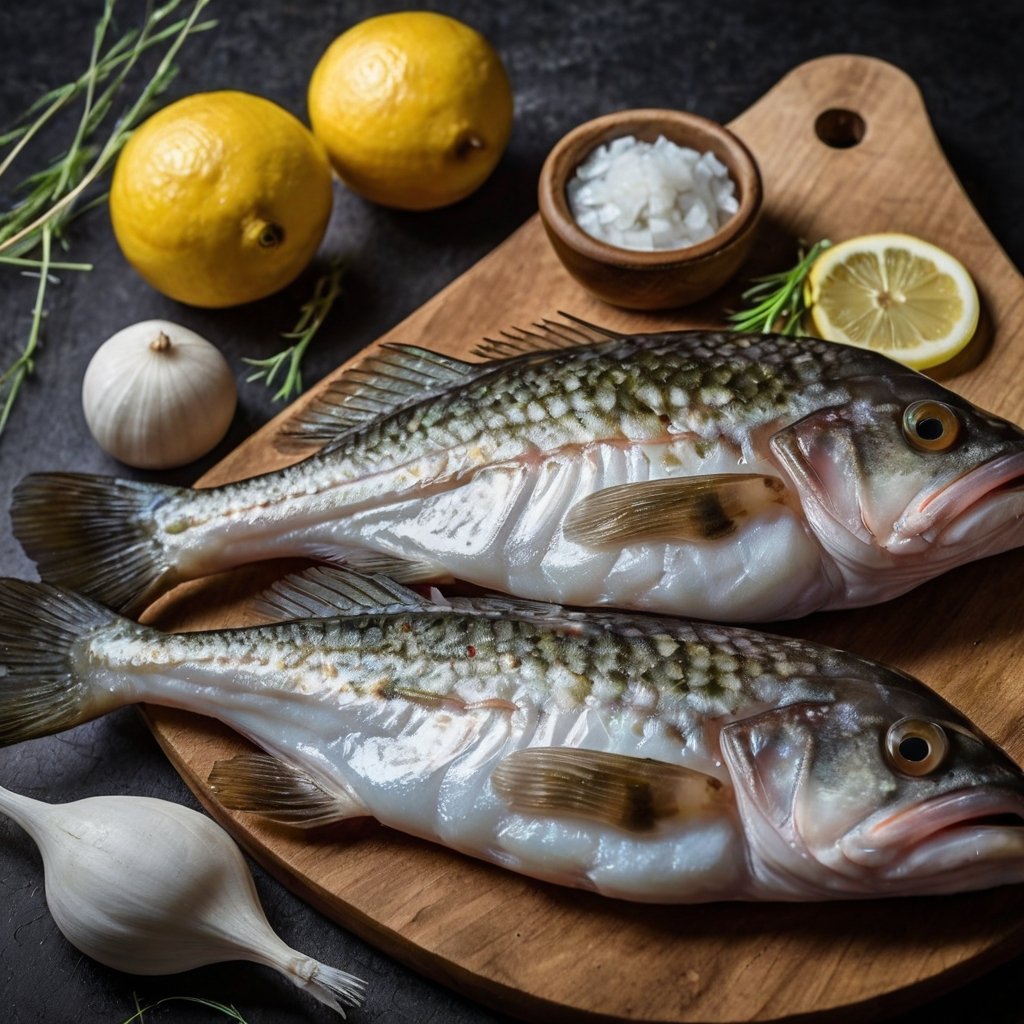Cod fish is a staple in cuisines around the world, loved for its versatility and mild flavor. This white-fleshed fish is enjoyed in everything from family dinners to fine dining restaurants.
Choosing the right cod for your meal can make a huge difference in taste and texture. Fresh cod should have a clean, ocean smell and firm flesh that bounces back when pressed.
In this guide, we’ll explore:
- The nutritional benefits of cod
- Different cooking methods for cod
- Tips for selecting and preparing cod
Whether you’re cooking a simple weeknight meal or hosting a special seafood dinner, this guide will help you make the best choices for your cod dishes.

Nutritional Benefits of Cod Fish
Cod fish stands out as a nutritional powerhouse, packed with essential nutrients that support your daily health needs. A single 3-ounce serving of cod delivers 15-20 grams of high-quality lean protein, making it an excellent choice for muscle maintenance and growth.
Protein Powerhouse
The protein content in cod offers specific health advantages:
- Supports muscle repair and recovery
- Helps maintain healthy bones
- Promotes feelings of fullness and satiety
- Assists in maintaining stable blood sugar levels
Selenium Superfood
Cod’s impressive selenium content sets it apart from many other protein sources. A standard serving provides up to 40% of your daily selenium needs. This essential mineral plays crucial roles in your body:
- Powers your thyroid function
- Strengthens your immune system
- Protects cells from oxidative damage
- Supports reproductive health
- Aids in DNA synthesis
Mercury Levels Matter
When it comes to mercury levels, cod presents a safer option compared to many popular fish varieties:
| Fish Type Mercury Level (PPM) Cod | 0.111 |
| Halibut | 0.241 |
| Tuna (Albacore) | 0.358 |
Additional Nutritional Benefits
Beyond these primary benefits, cod delivers additional nutritional value through:
- Vitamin B12 for nerve function and red blood cell formation
- Phosphorus for bone health
- Iodine for thyroid function
- Low-fat content (less than 1 gram per serving)
The combination of high protein and low fat makes cod an ideal choice for those following weight management programs or seeking to improve their dietary protein intake. Its mild flavor and versatile nature allow you to incorporate these nutritional benefits into various healthy meal options.
Types of Cod Fish Available
Different cod varieties offer unique characteristics that can enhance your culinary creations. Let’s explore the distinct types of cod fish available in markets today.
Atlantic Cod
Atlantic cod is a popular choice in many coastal areas. This classic variety has:
- Texture: Lean, firm flesh that flakes beautifully when cooked
- Color: Pure white meat with a clean, translucent appearance
- Taste Profile: Mild, slightly sweet flavor with subtle notes of ocean freshness
The versatility of Atlantic cod makes it perfect for:
- Fish and chips
- Baked fillets
- Pan-seared dishes
- Traditional salt cod preparations
Atlantic cod adapts well to various cooking methods:
- Baking: Creates tender, moist results
- Frying: Develops a crispy exterior while maintaining interior moisture
- Poaching: Preserves the delicate flavor
- Grilling: Adds a smoky dimension to the fish
Raw Atlantic cod fillets display these key characteristics:
- Firm, resilient flesh that springs back when pressed
- Translucent appearance with no discoloration
- Clean, sea-fresh aroma
- Consistent white coloring throughout
The size of Atlantic cod fillets ranges from 4-12 ounces, making portion control easy for both home cooking and restaurant service. The fish responds well to different preparation methods:
- Simple preparations: Light seasoning with herbs, lemon, and butter
- Complex dishes: Base for fish stews and chowders
- Traditional recipes: Salt cod dishes like bacalao
- Modern interpretations: Fish tacos and Asian-fusion preparations
Atlantic cod’s mild flavor creates an excellent canvas for:
- Herb crusts
- Spice rubs
- Light marinades
- Delicate sauces
The fish maintains its structure during cooking, making it ideal for:
- Restaurant service
- Family meals
- Meal prep
- Frozen storage
Alaskan Cod
Alaskan cod has unique qualities that make it different from Atlantic cod. This Pacific variety has a slightly sweeter taste and large, tender flakes that hold their shape when cooked.
The clean, cold waters of Alaska give the fish its pure flavor and bright white flesh. You’ll really notice these qualities when you make simple dishes like pan-seared fillets or fish and chips.
Key Features of Alaskan Cod:
- Milder, sweeter taste than Atlantic cod
- Larger, more defined flakes
- Firmer texture that holds up well in soups and stews
- Lower oil content, making it ideal for light cooking methods
- Excellent source of lean protein with only 82 calories per 100g serving
The versatility of Alaskan cod shines through its adaptability to various cooking methods. The firm texture makes it perfect for:
- Grilling without falling apart
- Deep frying for crispy fish and chips
- Poaching in aromatic broths
- Baking with minimal seasoning
Wild-caught Alaskan cod is certified sustainable by the Marine Stewardship Council, reflecting responsible fishing practices in the North Pacific. This certification ensures you’re making an environmentally conscious choice while enjoying premium quality fish.

Black Cod (Miso Cod)
Black cod, also known as sablefish, stands out from its Atlantic and Alaskan cousins with its rich, buttery texture and sweet, delicate flavor. This premium fish contains higher omega-3 fatty acid content than traditional cod varieties, creating a luxurious mouthfeel that melts effortlessly on your tongue.
The natural oils in black cod make it particularly suitable for various cooking methods:
- Broiling: Creates a caramelized exterior while maintaining moisture
- Grilling: Develops a smoky flavor without drying out
- Pan-searing: Forms a crispy skin while keeping the flesh tender
The most celebrated preparation of black cod is the Miso Black Cod, a dish popularized by celebrity chef Nobu Matsuhisa. This Japanese-inspired recipe transforms the fish through a sweet-savory marinade of miso paste, mirin, and sake. The marinade penetrates deep into the flesh, creating complex layers of umami flavors.
You can recreate this signature dish at home with these key ingredients:
- White miso paste
- Mirin (sweet rice wine)
- Sake
- Sugar
- Soy sauce
The fish requires a minimum 24-hour marination period to achieve its characteristic flavor profile. When cooked, the miso coating caramelizes beautifully, creating a glossy finish that complements the tender, flaky flesh beneath.
How to Select Quality Cod Fish
Selecting high-quality cod fish requires attention to specific details, whether you’re buying fresh or frozen varieties. Here’s what you need to know to make the best choice:
Fresh Cod Selection Indicators
- Clear, bright eyes with no cloudiness
- Firm, springy flesh that bounces back when pressed
- Translucent, moist appearance without discoloration
- Fresh, mild sea-breeze smell – avoid fish with strong fishy odors
- Skin should be metallic and shiny, not dull or slimy
- Red gills, free from slime or dark spots
Frozen Cod Guidelines
- Check for intact, sealed packaging without tears or holes
- Avoid packages with visible ice crystals or freezer burn
- Look for individually vacuum-sealed portions
- Select packages that feel solid without soft spots
- Check the production and best-before dates
- Ensure the fish was frozen at peak freshness
Sourcing Tips
- Buy from certified sustainable fisheries
- Choose retailers with high turnover rates
- Ask about delivery schedules to get the freshest catch
- Build relationships with local fishmongers
- Request to see quality certifications
- Check online reviews and ratings of suppliers
Storage Recommendations
- Keep fresh cod at 32-38°F (0-3°C)
- Use fresh cod within 1-2 days of purchase
- Store frozen cod at 0°F (-18°C) or below
- Avoid repeated thawing and refreezing
- Place fresh fish in a sealed container on ice
- Position the fish at the bottom of your refrigerator
Your cod selection significantly impacts the final taste and texture of your dish. Quality indicators remain consistent across different cod varieties, making these guidelines applicable whether you’re purchasing Atlantic, Pacific, or other cod species.
Preparation Methods for Cod Fish
Cod fish shines through various cooking techniques, each bringing out unique flavors and textures in this versatile seafood. Here’s your guide to mastering different preparation methods:
Baking
Baking cod preserves its natural moisture while infusing flavors. Try this Lemon-Crusted Cod recipe:
- Preheat oven to 400°F (200°C)
- Pat cod fillets dry with paper towels
- Mix breadcrumbs, lemon zest, herbs
- Brush fillets with melted butter
- Press breadcrumb mixture on top
- Bake 12-15 minutes until flaky
Pan-Frying
Pan-frying creates a golden crust while maintaining tenderness. Follow these steps for perfect results:
- Heat oil until shimmering but not smoking
- Season cod with salt and pepper
- Cook 4-5 minutes per side
- Remove when internal temperature reaches 145°F
Grilling
Grilling adds smoky flavors to cod. Keep these tips in mind:
- Oil grill grates thoroughly
- Use a fish basket for delicate fillets
- Maintain medium-high heat (375-400°F)
- Grill 4-5 minutes per side
Pro Tips for Moisture Retention
- Brush fish with oil or butter before cooking
- Use marinades with acid (lemon, vinegar) for 30 minutes max
- Let fish rest at room temperature 15 minutes before cooking
- Check doneness by testing flakiness with a fork
Temperature Guide
| Cooking Method Temperature Baking | 400°F (200°C) |
| Pan-Frying | Medium-high heat |
| Grilling | 375-400°F |
Each cooking method works particularly well with specific cod varieties:
- Atlantic Cod: Ideal for baking and pan-frying
- Alaskan Cod: Perfect for grilling
- Black Cod: Exceptional when broiled or pan-seared
Remember to adjust cooking times based on fillet thickness – a general rule is 10 minutes per inch of thickness.
Popular Cod Dishes and Recipes You Must Try!
Cod’s versatility shines through centuries of culinary traditions, creating an impressive array of dishes that span cultures and cooking styles.
Traditional Favorites
1. Bacalaitos (Puerto Rican Codfish Fritters)
- Shredded salted cod mixed with flour, herbs, and spices
- Crispy exterior with a tender, flaky interior
- Served as street food or appetizers
- Perfect with garlic sauce or hot sauce
2. Fish and Chips
- British classic featuring battered cod
- Beer-battered coating for extra crispiness
- Served with thick-cut fries and malt vinegar
- Tartar sauce as traditional accompaniment
3. Portuguese Bacalhau à Brás
- Shredded cod with matchstick potatoes
- Scrambled with eggs and onions
- Garnished with black olives and parsley
- National dish status in Portugal
Modern Interpretations
4. Cod Fish Tacos
- Grilled or blackened cod pieces
- Fresh cabbage slaw with lime
- Chipotle or avocado crema
- Corn tortillas for authentic taste
5. Mediterranean Cod Salad
- Pan-seared cod flakes
- Mixed greens and cherry tomatoes
- Kalamata olives and feta cheese
- Lemon-herb vinaigrette dressing
6. Asian-Fusion Cod Bowl
- Teriyaki-glazed cod
- Steamed rice or quinoa base
- Pickled vegetables
- Sesame seeds and nori strips
These dishes showcase cod’s ability to absorb flavors while maintaining its distinct texture. Each recipe brings unique ingredients and cooking methods, creating memorable dining experiences. The fish’s mild flavor makes it an ideal canvas for both bold seasonings and subtle aromatics.

Cooking Tips for Optimal Results with Cod Fish
Mastering cod preparation starts with proper marination. A simple marinade of olive oil, lemon juice, and herbs penetrates the flesh, creating layers of flavor while keeping the fish moist during cooking. Let your cod marinate for 30 minutes to 2 hours – any longer risks breaking down the delicate flesh.
Essential Marinating Tips:
- Use acid-based marinades sparingly (lemon juice, vinegar)
- Add oil to help seasonings stick and prevent drying
- Include fresh herbs like dill, parsley, or thyme
- Keep marination time under 2 hours
- Pat fish dry before cooking to achieve better browning
Moisture Retention Techniques:
- Brush fish with oil or butter before cooking
- Create a protective coating using breadcrumbs or herbs
- Cook at medium-high heat (375°F/190°C)
- Avoid moving the fish frequently during cooking
- Use a meat thermometer to prevent overcooking (145°F/63°C)
Creating a steam environment helps lock in moisture. Place a pan of water on the bottom rack of your oven while baking, or wrap cod in parchment paper with butter and herbs. For pan-frying, a quick 3-4 minutes per side preserves the fish’s natural juices.
Pro Tip: Basting your cod every few minutes during cooking adds flavor and creates a protective layer that seals in moisture. A mixture of melted butter, lemon juice, and white wine works perfectly for this technique.
Remember to let your cod rest for 3-5 minutes after cooking. This allows the juices to redistribute throughout the fish, ensuring each bite remains succulent and flavorful.
If you’re looking for inspiration beyond cod, you might want to explore some baked pomfret recipes which use similar techniques. And if you’re interested in perfecting your overall fish cooking skills, consider checking out some tips on how to cook salmon properly as well.
Conclusion
Choosing the best cod fish can turn a regular meal into an amazing dining experience. You can enjoy cod fish in many ways, whether you prefer traditional baked fillets or creative fusion dishes.
Cod fish is versatile and offers countless options in your kitchen:
- Experiment with flavors: Try Asian-inspired marinades, Mediterranean herbs, or spicy Caribbean seasonings
- Mix cooking methods: Switch between baking, grilling, and pan-searing to discover your favorite technique
- Create fusion dishes: Combine traditional recipes with modern twists for unique meal experiences
With each shopping trip, you’ll become more confident in selecting quality cod. Keep these important factors in mind:
- Fresh cod should have a clean ocean scent
- The flesh should be firm and translucent
- Quality frozen cod comes from reputable suppliers
The mild taste of cod fish makes it suitable for both beginner and experienced cooks. Whether you’re making a quick dinner during the week or hosting a special event, cod fish provides nutrition and satisfaction.
Start your journey of cooking with cod fish today – your family’s new favorite meal might be just one recipe away.
FAQs (Frequently Asked Questions)
What are the nutritional benefits of cod fish?
Cod fish is a great source of lean protein and is rich in selenium, which plays a vital role in bodily functions and has antioxidant properties. Additionally, cod has lower mercury levels compared to other fish such as halibut and tuna, making it a healthier choice for regular consumption.
What types of cod fish are available?
There are several types of cod fish, including Atlantic cod, Alaskan cod, black cod (miso cod), salted cod, dried cod, and cod fillets. Each type has distinct characteristics and flavor profiles that can influence their culinary uses.
How can I select quality cod fish?
When selecting fresh cod, look for indicators of freshness such as a clean smell, firm texture, and bright coloration. For frozen cod, check the packaging for signs of freezer burn and ensure it comes from reputable suppliers to guarantee quality.
What are some popular cooking methods for preparing cod fish?
Cod can be prepared using various cooking techniques including baking, frying, grilling, and broiling. Each method has its own advantages; for example, baking can enhance flavors while maintaining moisture when done correctly.
What are some traditional and modern dishes made with cod?
Traditional dishes include bacalaitos (codfish fritters), while modern variations feature recipes such as tacos or salads that incorporate cod. These dishes highlight the versatility of cod in different culinary contexts.
What tips can enhance the cooking process for cod fish?
To achieve optimal results with cod fish, consider marinating it to enhance flavor and using techniques that retain moisture during cooking. This will help prevent the fish from drying out and ensure a delicious meal.
